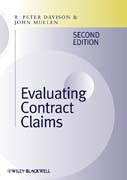
Most medium to large construction contracts include a claim for extra paymentfor variations or disruption to the programme. Whilst the causes of the claimare often well documented, what can and cannot be included in the payment is often misunderstood and the calculation of quantum consequently becomes vague and poorly substantiated. Thoroughly updated over the previous edition, reflecting pertinent Court decisions on damages and the duty to mitigate, the new edition covers new provisions of the revised JCT 2005 contracts and the 2005 NewEngineering Contract. There is substantial additional material on issues arising from time and delay analysis and the financial consequences of changes to time issues that regularly cause real problems in the evaluation of quantum for construction claims. Most current books on the subject concentrate on the establishment of liability and the requirements of individual standard forms of contract. This book, however, concentrates on the quantification of claims after liability has been established, regardless of the form of contract used, and sets out the principles and methods that should be reflected in the evaluation of claim quantum and the standard of substantiation required. It will therefore appeal to those working with both building and engineering contracts.Reviews of the previous edition"Well written and highly informative" Building EngineerHis observations on the assessment of productivity and the use of facilities and equipment are particularly helpful for lawyers, who deal with construction claims Construction LawThe AuthorsPeter Davison BA MSc FRICS FCIArb has spent much of his career as a quantity surveyor working on projects in many parts of the UK, Europe, and the Middle and Far East. He worked for civil and mechanical engineering contractors, client organisations and consultants before founding Davison George and Partners in 1982, now Driver Consult Ltd. A Fellow of the Royal Institution of Chartered Surveyors and the Chartered Institute of Arbitrators, he has also sat as an Arbitrator on major international disputes administered by the International Chamber of Commerce.John Mullen BSc(Hons) MSc FRICS FInstCES FCIArb MAE began his training with a national firm of contractors, subsequently moving into private practice and has specialised for the last 25 years in providing consultancy services to the building and engineering construction industries. He has enjoyed over 40 appointments as an expert witness in cases at the High Court, International Chamber of Commerce arbitration,and in domestic arbitration. INDICE: 1 Introduction. 2 Establishing the base. 3 Effect of change on programmes of work. 4 Sources of financial information for evaluation. 5 Evaluation of the direct consequences of change. 6 Evaluation of the time consequencesof change. 7 Other sources of claims. 8 Minimising the consequences of change. Appendix A: Example of financial accounts. Appendix B: Example of managementaccounts. Table of Cases
- ISBN: 978-1-4051-5920-3
- Editorial: Blackwell
- Encuadernacion: Cartoné
- Páginas: 320
- Fecha Publicación: 14/11/2008
- Nº Volúmenes: 1
- Idioma: Inglés
